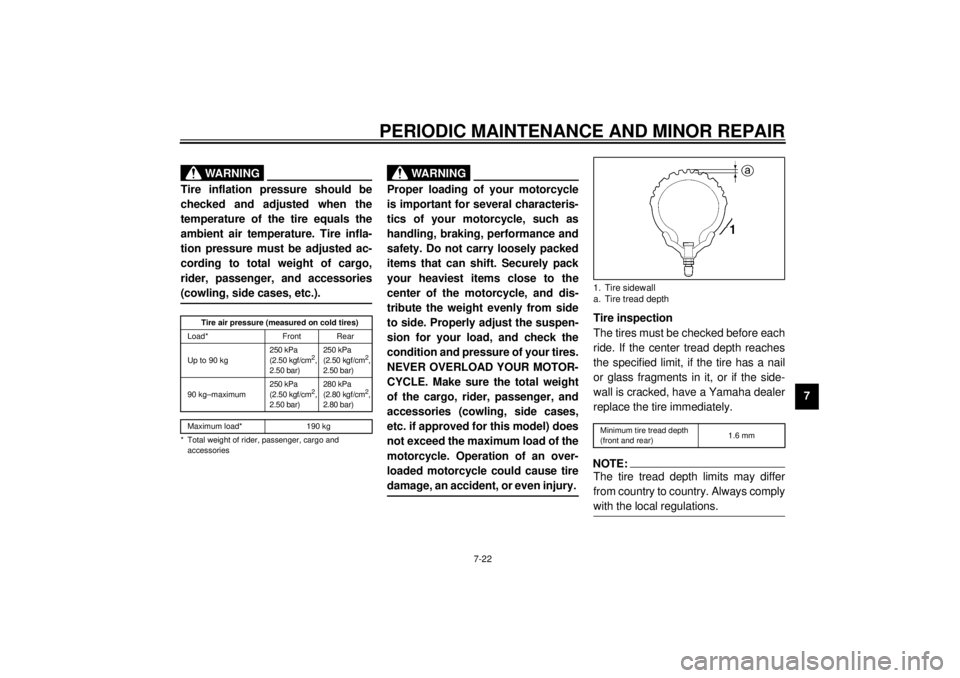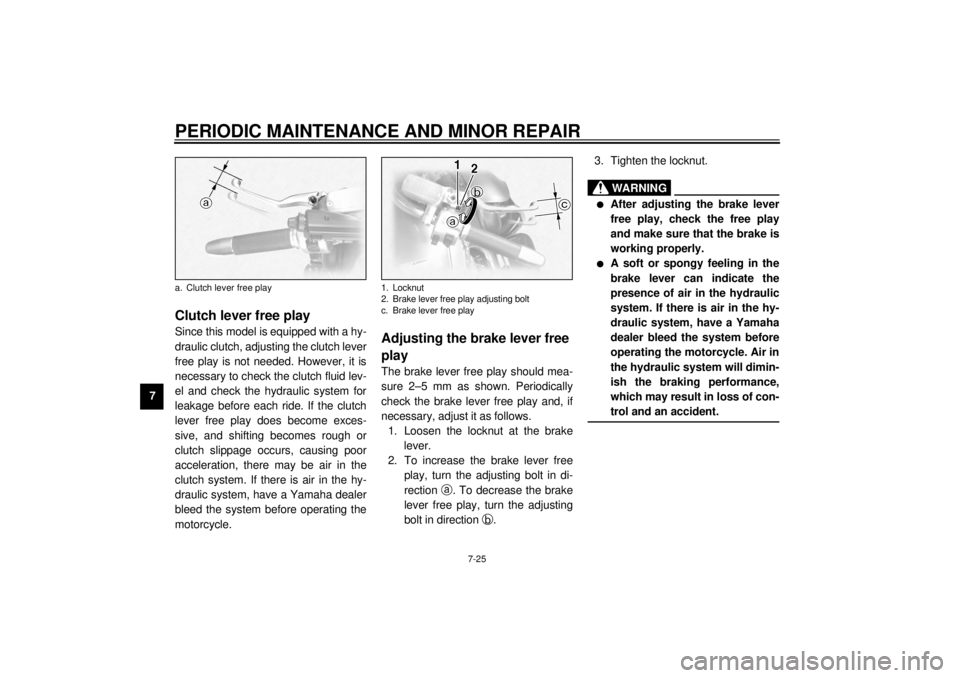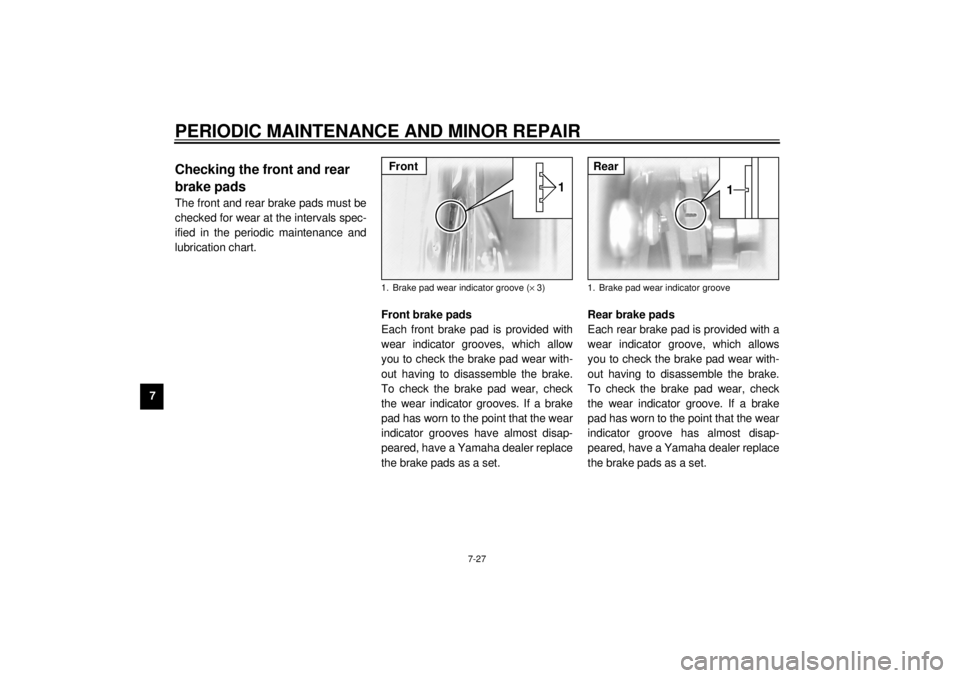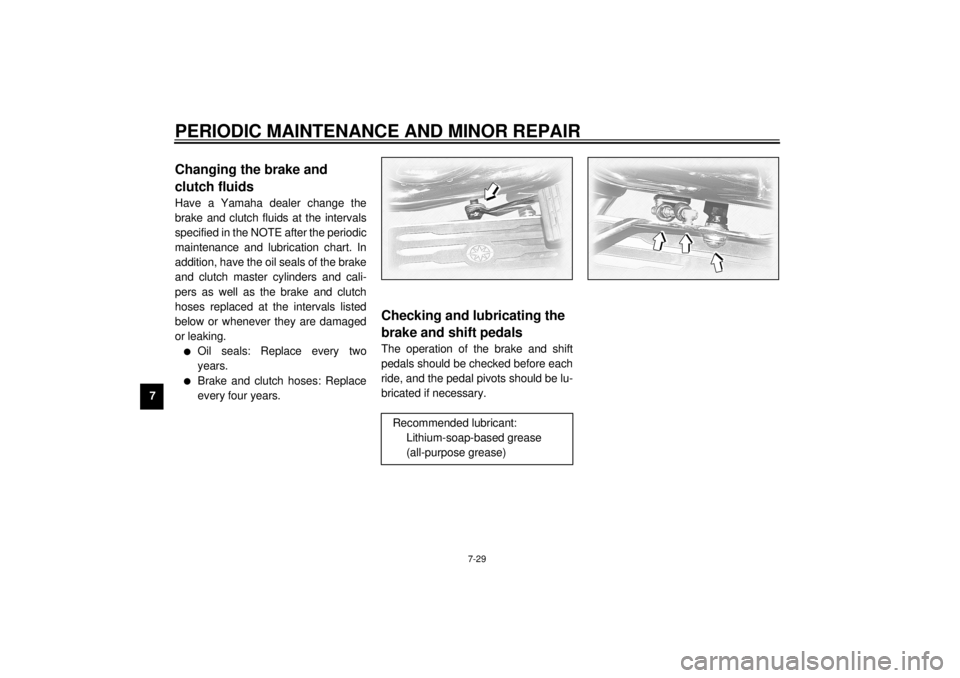2001 YAMAHA XVZ1300TF maintenance
[x] Cancel search: maintenancePage 95 of 132

PERIODIC MAINTENANCE AND MINOR REPAIR
7-22
7
EWA00041
WARNING
_ Tire inflation pressure should be
checked and adjusted when the
temperature of the tire equals the
ambient air temperature. Tire infla-
tion pressure must be adjusted ac-
cording to total weight of cargo,
rider, passenger, and accessories
(cowling, side cases, etc.). _CE-21E
CE-07EEWA00042
WARNING
_ Proper loading of your motorcycle
is important for several characteris-
tics of your motorcycle, such as
handling, braking, performance and
safety. Do not carry loosely packed
items that can shift. Securely pack
your heaviest items close to the
center of the motorcycle, and dis-
tribute the weight evenly from side
to side. Properly adjust the suspen-
sion for your load, and check the
condition and pressure of your tires.
NEVER OVERLOAD YOUR MOTOR-
CYCLE. Make sure the total weight
of the cargo, rider, passenger, and
accessories (cowling, side cases,
etc. if approved for this model) does
not exceed the maximum load of the
motorcycle. Operation of an over-
loaded motorcycle could cause tire
damage, an accident, or even injury. _
Tire inspection
The tires must be checked before each
ride. If the center tread depth reaches
the specified limit, if the tire has a nail
or glass fragments in it, or if the side-
wall is cracked, have a Yamaha dealer
replace the tire immediately.CE-08ENOTE:_ The tire tread depth limits may differ
from country to country. Always comply
with the local regulations. _
Tire air pressure (measured on cold tires)
Load* Front Rear
Up to 90 kg250 kPa
(2.50 kgf/cm
2,
2.50 bar)250 kPa
(2.50 kgf/cm
2,
2.50 bar)
90 kg–maximum250 kPa
(2.50 kgf/cm
2,
2.50 bar)280 kPa
(2.80 kgf/cm
2,
2.80 bar)
Maximum load* 190 kg
* Total weight of rider, passenger, cargo and
accessories
1. Tire sidewall
a. Tire tread depthMinimum tire tread depth
(front and rear)1.6 mm
E_5jc.book Page 22 Monday, January 22, 2001 12:12 PM
Page 96 of 132

PERIODIC MAINTENANCE AND MINOR REPAIR
7-23
7
EW000079
WARNING
_ l
Have a Yamaha dealer replace
excessively worn tires. Besides
being illegal, operating the
motorcycle with excessively
worn tires decreases riding sta-
bility and can lead to loss of
control.
l
The replacement of all wheel-
and brake-related parts, includ-
ing the tires, should be left to a
Yamaha dealer, who has the
necessary professional knowl-
edge and experience.
_
Tire information
This motorcycle is equipped with tube-
less tires, tire air valves and cast
wheels.
EW000132
WARNING
_ l
The front and rear tires should
be of the same make and de-
sign, otherwise the handling
characteristics of the motor-
cycle cannot be guaranteed.
l
After extensive tests, only the
tires listed below have been ap-
proved for this model by
Yamaha Motor Co., Ltd.
l
Always make sure that the valve
caps are securely installed to
prevent air pressure leakage.
l
Use only the tire valves and
valve cores listed below to
avoid tire deflation during a
ride.
_
1. Tire air valve
2. Tire air valve core
3. Tire air valve cap with seal
E_5jc.book Page 23 Monday, January 22, 2001 12:12 PM
Page 97 of 132

PERIODIC MAINTENANCE AND MINOR REPAIR
7-24
7
CE-11E
CE-12EEAU03763
Cast wheels To maximize the performance, durabil-
ity, and safe operation of your motor-
cycle, note the following points
regarding the specified wheels.l
The wheel rims should be checked
for cracks, bends, warpage or
damage before each ride. If any
damage is found, have a Yamaha
dealer replace the wheel. Do not
attempt even the smallest repair to
the wheel. A deformed or cracked
wheel must be replaced.
l
The wheel should be balanced
whenever either the tire or wheel
has been changed or replaced. An
unbalanced wheel can result in
poor performance, adverse han-
dling characteristics, and a short-
ened tire life.
l
Ride at moderate speeds after
changing a tire since the tire sur-
face must first be “broken in” for it
to develop its optimal characteris-
tics.
l
After repairing or replacing the
rear tire, tighten the valve stem nut
and locknut to the specified
torques.
FRONT
Manufacturer Size Type
Dunlop 150/80-16 71H D404F
Bridgestone 150/80-16 71H G705
Tire air valve TR412
Valve core #9000A
REAR
Manufacturer Size Type
Dunlop 150/90B 15M/C 74H D404
Bridgestone 150/90B 15M/C 74H G702
Tire air valve PVR59A
Valve core #9000
Tightening torques:
Valve stem nut:
1.6 Nm (0.16 m·kgf)
Valve stem locknut:
1.6 Nm (0.16 m·kgf)
E_5jc.book Page 24 Monday, January 22, 2001 12:12 PM
Page 98 of 132

PERIODIC MAINTENANCE AND MINOR REPAIR
7-25
7
EAU00695
Clutch lever free play Since this model is equipped with a hy-
draulic clutch, adjusting the clutch lever
free play is not needed. However, it is
necessary to check the clutch fluid lev-
el and check the hydraulic system for
leakage before each ride. If the clutch
lever free play does become exces-
sive, and shifting becomes rough or
clutch slippage occurs, causing poor
acceleration, there may be air in the
clutch system. If there is air in the hy-
draulic system, have a Yamaha dealer
bleed the system before operating the
motorcycle.
EAU00696
Adjusting the brake lever free
play The brake lever free play should mea-
sure 2–5 mm as shown. Periodically
check the brake lever free play and, if
necessary, adjust it as follows.
1. Loosen the locknut at the brake
lever.
2. To increase the brake lever free
play, turn the adjusting bolt in di-
rection
a. To decrease the brake
lever free play, turn the adjusting
bolt in direction
b.3. Tighten the locknut.
EW000099
WARNING
@ l
After adjusting the brake lever
free play, check the free play
and make sure that the brake is
working properly.
l
A soft or spongy feeling in the
brake lever can indicate the
presence of air in the hydraulic
system. If there is air in the hy-
draulic system, have a Yamaha
dealer bleed the system before
operating the motorcycle. Air in
the hydraulic system will dimin-
ish the braking performance,
which may result in loss of con-
trol and an accident.
@
a. Clutch lever free play
1. Locknut
2. Brake lever free play adjusting bolt
c. Brake lever free play
E_5jc.book Page 25 Monday, January 22, 2001 12:12 PM
Page 99 of 132

PERIODIC MAINTENANCE AND MINOR REPAIR
7-26
7
EAU01746
Adjusting the brake pedal
position The top of the brake pedal should be
positioned approximately 100 mm
above the top of the footrest as shown.
Periodically check the brake pedal po-
sition and, if necessary, have a
Yamaha dealer adjust it.
EW000109
WARNING
@ A soft or spongy feeling in the brake
pedal can indicate the presence of
air in the hydraulic system. If there
is air in the hydraulic system, have a
Yamaha dealer bleed the system be-
fore operating the motorcycle. Air in
the hydraulic system will diminish
the braking performance, which
may result in loss of control and an
accident. @
EAU01799
Adjusting the rear brake light
switch The rear brake light switch, which is ac-
tivated by the brake pedal, is properly
adjusted when the brake light comes
on just before braking takes effect.
Since the brake light switch is a compo-
nent of the cruise control system, it
must be adjusted by a Yamaha dealer,
who has the necessary professional
knowledge and experience.
a. Distance between brake pedal and footrest
E_5jc.book Page 26 Monday, January 22, 2001 12:12 PM
Page 100 of 132

PERIODIC MAINTENANCE AND MINOR REPAIR
7-27
7
EAU00721
Checking the front and rear
brake pads The front and rear brake pads must be
checked for wear at the intervals spec-
ified in the periodic maintenance and
lubrication chart.
EAU03938
Front brake pads
Each front brake pad is provided with
wear indicator grooves, which allow
you to check the brake pad wear with-
out having to disassemble the brake.
To check the brake pad wear, check
the wear indicator grooves. If a brake
pad has worn to the point that the wear
indicator grooves have almost disap-
peared, have a Yamaha dealer replace
the brake pads as a set.
EAU03939
Rear brake pads
Each rear brake pad is provided with a
wear indicator groove, which allows
you to check the brake pad wear with-
out having to disassemble the brake.
To check the brake pad wear, check
the wear indicator groove. If a brake
pad has worn to the point that the wear
indicator groove has almost disap-
peared, have a Yamaha dealer replace
the brake pads as a set.
1. Brake pad wear indicator groove (´ 3)Front
1. Brake pad wear indicator grooveRear
E_5jc.book Page 27 Monday, January 22, 2001 12:12 PM
Page 101 of 132

PERIODIC MAINTENANCE AND MINOR REPAIR
7-28
7
EAU03914
Checking the brake and clutch
fluid levels Insufficient brake or clutch fluid may al-
low air to enter the brake or clutch sys-
tems, possibly causing them to
become ineffective.
Before riding, check that the brake and
clutch fluids are above the minimum
level marks and replenish if necessary.
A low brake or clutch fluid level may in-
dicate brake or clutch system leakage
and/or worn brake pads. If the brake or
clutch levels are low, be sure to check
the brake or clutch systems for leakage
and the brake pads for wear.Observe these precautions:
l
When checking the brake and
clutch fluid levels, make sure that
the top of each reservoir is level.
l
Use only the recommended quali-
ty brake fluid, otherwise the rubber
seals may deteriorate, causing
leakage and poor braking or clutch
performance.
l
Refill with the same type of brake
fluid. Mixing fluids may result in a
harmful chemical reaction and
lead to poor braking or clutch per-
formance.
l
Be careful that water does not en-
ter the brake or clutch fluid reser-
voir when refilling. Water will
significantly lower the boiling point
of the fluid and may result in vapor
lock.
l
Brake fluid may deteriorate paint-
ed surfaces or plastic parts. Al-
ways clean up spilled fluid
immediately.
l
As the brake pads wear, it is nor-
mal for the brake fluid level to
gradually go down. However, if the
brake fluid level goes down sud-
denly, have a Yamaha dealer
check the cause.
1. Minimum level markFront brake
1. Minimum level markRecommended brake and clutch
fluid: DOT 4 brake fluidRear brake
1. Minimum level markClutch
E_5jc.book Page 28 Monday, January 22, 2001 12:12 PM
Page 102 of 132

PERIODIC MAINTENANCE AND MINOR REPAIR
7-29
7
EAU03984
Changing the brake and
clutch fluids Have a Yamaha dealer change the
brake and clutch fluids at the intervals
specified in the NOTE after the periodic
maintenance and lubrication chart. In
addition, have the oil seals of the brake
and clutch master cylinders and cali-
pers as well as the brake and clutch
hoses replaced at the intervals listed
below or whenever they are damaged
or leaking.l
Oil seals: Replace every two
years.
l
Brake and clutch hoses: Replace
every four years.
EAU03370
Checking and lubricating the
brake and shift pedals The operation of the brake and shift
pedals should be checked before each
ride, and the pedal pivots should be lu-
bricated if necessary.
Recommended lubricant:
Lithium-soap-based grease
(all-purpose grease)
E_5jc.book Page 29 Monday, January 22, 2001 12:12 PM